One of Nazi Germany’s last-ditch efforts to regain control of the sky with a cheap jet fighter that could be flown by virtually anyone was the Heinkel He162
One of Nazi Germany’s last-ditch efforts to regain control of the sky with a cheap jet fighter that could be flown by virtually anyone was the Heinkel He 162 but it arrived too late to have any impact on how the battle turned out, just like all the other weaponry.
The Western Allies and the Russians were encroaching on the boundaries of Germany by September 1944, according to the website of the Royal Air Force Museum, and in a last-ditch effort to reverse their defeats, the Germans started a frantic quest for a war-winning “wonder weapon.”
The German aviation industry created a variety of designs, such as the He 162 jet fighter, also known as the “Volksjäger” (People’s Fighter). It was built with a significant percentage of wood due to a lack of light alloys, and it was intended for mass manufacturing by semi-skilled labor at a variety of scattered sites.
It only took 69 days from the beginning of design work to its first flight during a severe time. The airplane had poor flying qualities, as one could anticipate from such a hastily constructed design.
The He 162s were hardly ever seen in combat. Deliveries to Luftwaffe units started in February 1945, although in the type’s brief service history, just two victories — both of which were unverified — were claimed. Even though there were plans for a monthly production of 4,000, by the conclusion of the war, the German Air Force had only received less than 200.

Notably, Heinkel developed the pulsejet project as a continuation of the He 162 development, and it was described in a report that was released on March 30, 1945, two days prior to the Soviet army’s onslaught towards Vienna, where Heinkel’s design team was stationed. However, it would seem that the project had already been in motion for a while before the announcement of a He 162 powered by pulsejets in connection with Junkers EF 126 ‘Elli’ in January.
In Dan Sharp’s book Secret Projects of the Luftwaffe Volume 1 Jet Fighters 1939–1945, there was a brief summary that read as follows: “The occasion for investigation of the 162 with Argus tubes was the considerably lower cost of producing the Argus tubes in comparison with the turbojet power unit. The drawbacks are the great fuel consumption, low altitude output, and the necessity for supplementary starting aid. The velocities at lower altitudes, however, are only slightly inferior to the value attainable with turbojet units.
“We have the choice between different-size Argus tubes, the As 014 tube with 335kg static thrust and the As 044 with 500kg static thrust. We investigated the employment of two As 014 tubes above the fuselage, and also of one As 044 tube similarly placed. In contrast with report 114/44, we are nevertheless suggesting the installation of one As 044 tube, owing to the increased thrust which has meanwhile been developed. The arrangement with one tube gives a considerably better rear field of view than with two tubes. For the installation of two strong As 044 tubes, allowing for at least 20 min duration of full-throttle flight at ground level, the body of 162 is too small (approximately 2.2 tons of fuel are required).
“As a result of the pronounced falling-off in the power unit’s thrust with altitude (more than with air density), the maximum speed is attained at ground level. For the same reason, flight performance is poor at greater altitudes, so the operational flight can only be considered at low altitudes. Take-off must be effected by having recourse to auxiliary starting aid. If the take-off position is not to be betrayed by the smoke of the starting rockets it will necessary to employ a catapulting device. The amount of fuel required may be completely housed in the fuselage and wing, making external tanks superfluous. The supply of auxiliary power for the radio, fuel, and hydraulic systems, is provided by a generating set on board the aircraft.”
The report also included two drawings, numbered 162.01-43 and 162.01-44, both dated March 30, 1945. In the former, a large As 044 was put on the back of the He 162, but in the latter, two As 014 were mounted side by side.
There is a third, unnumbered drawing that shows the As 044 design with a pair of significantly longer-barrelled weapons, likely MK 103s, with their barrels protruding from the sides of the aircraft’s fuselage. Armament was a pair of MK 108s in each case.
It is unclear why Heinkel bothered with this project as the Argus pulsejet vibrations appeared to be uncurable.
Secret Projects of the Luftwaffe Volume 1 Jet Fighters 1939-1945 is published by Mortons Books and is available to order here.
Photo by Top image unknown and Toshonenov own work via Wikipedia

